Numerical Simulation of Na-Tech Cascading Disasters in a Large Oil Depot
Abstract
:1. Introduction
2. Scene Construction
3. Analysis of Heavy-Rainfall-Induced Slope Deformation and Damage
3.1. Method
3.2. Model Parameter Setting
3.3. Analysis of the Simulation Result
4. Analysis of Damages in the Oil Transportation Pipeline Structure
4.1. Boundary and Load Conditions Setting
4.2. Analysis of the Simulation Results
5. Analysis of Pipeline Leakage Resulting in Flammable Vapor Cloud Explosion
5.1. Boundary Conditions Setting
5.2. Simulation of Gasoline Leakage
5.3. Simulation of Explosion
6. Conclusions
- (1)
- The DEM method was used to simulate the movement of blocks in a rain-induced landslide and to produce a time-history curve of contact force when the blocks impacted the oil pipeline. The blocks that disintegrated from a sliding mass had a maximum rolling speed of 30 m/s and broke the pipeline at the bottom of the slope in 10–12 s from when the landslide occurred, with the largest contact force being over 7 MN.
- (2)
- The FEM was employed to simulate the nonlinear failure of the pipeline when it was hit by the blocks. According to the contact force curve, we incorporated impact load into the simulation and observed that the pipeline fractured completely at 51 ms after impacted; the actual critical load was 1.45 MN, which was only 20% of the maximum contact force during impacted by the blocks.
- (3)
- The FVM was used to simulate the process in which the gasoline leaked out from where the pipeline fractured and gathered into a pool; the pool expanded while the gas evaporated; the evaporated gas formed a flammable vapor cloud; and the cloud caused an explosion. According to the simulation results, the gasoline leaked out from the fracture point; the gasoline covered the entire area enclosed by the firewalls where the fractured pipeline was located after 200 s of leakage and then spread to other areas. After 2595 s of leakage, the gasoline spread nearly 400 m to the south, more than 450 m to the east, and more than 200 m to the north, reaching the retaining wall for the northern slope.
- (4)
- An ignition source was simulated in the fire pumping station located at the right of the leaking pipeline, and this ignition source resulted in an explosion with a blast radius of more than 150 m. According to the overpressure damage standards and the distribution of personnel, equipment, and buildings on-site, we determined the magnitude of damage by the explosion overpressure to personnel, equipment and buildings.
- (5)
- For large oil depots with side slopes around, geometrical information of the slopes should be obtained through LIDAR scanning. Based on the analysis of slope deformation by LIDAR, dynamic risk assessment is to be conducted. Reinforcement measures should be taken for slopes with higher risk level, and sensors should be installed to facilitate risk-monitoring and warning issues, especially inspections coped with rainstorms. Additionally, scenarios of oil and gas leakage accidents should be constructed according to the reference [36], so as to identify risk factors that may cause derivative disasters. Pump houses, for instance, may constitute ignition sources, hence corresponding explosion-proof measures should be taken.
Author Contributions
Funding
Conflicts of Interest
References
- Cui, P.; Zhou, G.G.D.; Zhu, X.H.; Zhang, J.Q. Scale amplification of natural debris flows caused by cascading landslide dam failures. Geomorphology 2013, 182, 173–189. [Google Scholar] [CrossRef]
- Zhang, K.; Xue, X.; Hong, Y.; Gourley, J.J.; Lu, N.; Wan, Z.; Hong, Z.; Wooten, R. iCRESTRIGRS: A coupled modeling system for cascading flood–landslide disaster forecasting. Hydrol. Earth Syst. Sci. 2016, 20, 5035–5048. [Google Scholar] [CrossRef] [Green Version]
- Kim, Y.; Jeong, S.; Lee, K. Instability analysis of rainfall-induced landslides using hydro-mechanically coupled model. Jpn. Geotech. Soc. Spec. Publ. 2016, 2, 1002–1007. [Google Scholar] [CrossRef] [Green Version]
- Keijsers, J.G.S.; Schoorl, J.M.; Chang, K.T.; Chiang, S.H.; Claessens, L.; Veldkamp, A. Calibration and resolution effects on model performance for predicting shallow landslide locations in Taiwan. Geomorphology 2011, 133, 168–177. [Google Scholar] [CrossRef]
- Papa, M.N.; Medina, V.; Ciervo, F.; Bateman, A. Derivation of critical rainfall thresholds for shallow landslides as a tool for debris flow early warning systems. Hydrol. Earth Syst. Sci. 2013, 17, 4095–4107. [Google Scholar] [CrossRef] [Green Version]
- Jibson, R.W. Predicting earthquake-induced landslide displacements using Newmark’s sliding block analysis. Transp. Res. Rec. 1993, 1411, 9–17. [Google Scholar]
- Keefer, D.K. Statistical analysis of an earthquake-induced landslide distribution—The 1989 Loma Prieta, California event. Eng. Geol. 2000, 58, 231–249. [Google Scholar] [CrossRef]
- Baum, R.L.; Godt, J.W.; Savage, W.Z. Estimating the timing and location of shallow rainfall-induced landslides using a model for transient, unsaturated infiltration. J. Geophys. Res. Earth Surf. 2010, 115. [Google Scholar] [CrossRef]
- Liao, Z.; Hong, Y.; Kirschbaum, D.; Liu, C. Assessment of shallow landslides from Hurricane Mitch in central America using a physically based model. Environ. Earth Sci. 2012, 66, 1697–1705. [Google Scholar] [CrossRef]
- Montgomery, D.R.; Dietrich, W.E. A physically based model for the topographic control on shallow landsliding. Water Resour. Res. 1994, 30, 1153–1171. [Google Scholar] [CrossRef]
- Michel, G.P.; Kobiyama, M.; Goerl, R.F. Comparative analysis of SHALSTAB and SINMAP for landslide susceptibility mapping in the Cunha River basin, southern Brazil. J. Soils Sediments 2014, 14, 1266–1277. [Google Scholar] [CrossRef]
- Bhardwaj, A.; Wasson, R.J.; Ziegler, A.D.; Chow, W.T.; Sundriyal, Y.P. Characteristics of rain-induced landslides in the Indian Himalaya: A case study of the Mandakini Catchment during the 2013 flood. Geomorphology 2019, 330, 100–115. [Google Scholar] [CrossRef]
- Hua-Yong, C.H.E.N.; Peng, C.U.I.; Gordon, G.D.; Xing-Hua, Z.H.U.; Jin-Bo, T.A.N.G. Experimental study of debris flow caused by domino failures of landslide dams. Int. J. Sediment Res. 2014, 29, 414–422. [Google Scholar]
- Liu, W.; Wang, D.; Zhou, J.; He, S. Simulating the Xinmo landslide runout considering entrainment effect. Environ. Earth Sci. 2019, 78. [Google Scholar] [CrossRef]
- Liu, Q.C.; Xiong, C.R.; Ma, J.W. Study of Guizhou Province Guanling Daz-Hai Landslide Instability Process under the Rainstorm. Appl. Mech. Mater. 2015, 446–450. [Google Scholar] [CrossRef]
- Hansen, O.R.; Wingerden, K.V.; Pedersen, G.H.; Wilkins, B.A. Studying Gas Leak, Dispersion and Following Explosion after ignition in a Congested Environment Subject to a Predefined Wind-Field, Experiments and FLACS-simulations are Compared. In Proceedings of the 7th Annual Conference on Offshore Installations Fire and Explosion Engineering, London, UK, 2 December 1998. [Google Scholar]
- Gupta, N.K.; Sheriff, N.M.; Velmurugan, R. Experimental and numerical investigations into collapse behaviour of thin spherical shells under drop hammer impact. Int. J. Solids Struct. 2007, 44, 3136–3155. [Google Scholar] [CrossRef] [Green Version]
- Gschwind, S.; Loew, S.; Wolter, A. Multi-stage structural and kinematic analysis of a retrogressive rock slope instability complex (Preonzo, Switzerland). Eng. Geol. 2019, 252, 27–42. [Google Scholar] [CrossRef]
- Reichenbach, P.; Rossi, M.; Malamud, B.D.; Mihir, M.; Guzzetti, F. A review of statistically-based landslide susceptibility models. Earth Sci. Rev. 2018, 180, 60–91. [Google Scholar] [CrossRef]
- Hewitt, K.; Clague, J.J.; Orwin, J.F. Legacies of catastrophic rock slope failures in mountain landscapes. Earth Sci. Rev. 2008, 87, 1–38. [Google Scholar] [CrossRef]
- Trujillo-Vela, M.G.; Galindo-Torres, S.A.; Zhang, X.; Ramos-Cañón, A.M.; Escobar-Vargas, J.A. Smooth particle hydrodynamics and discrete element method coupling scheme for the simulation of debris flows. Comput. Geotech. 2020, 125, 103669. [Google Scholar] [CrossRef]
- Zheng, J.Y.; Zhang, B.J.; Liu, P.F.; Wu, L.L. Failure analysis and safety evaluation of buried pipeline due to deflection of landslide process. Eng. Fail. Anal. 2012, 25, 156–168. [Google Scholar] [CrossRef]
- Biscaia, H.C.; Chastre, C.; Silva, M.A. Modelling GFRP-to-concrete joints with interface finite elements with rupture based on the Mohr-Coulomb criterion. Constr. Build. Mater. 2013, 47, 261–273. [Google Scholar] [CrossRef]
- Jianjin, Q. Shenzhen Guanghui Oil Depot Phase II Landslide Treatment Project; Shenzhen Geotechnical Investigation and Surveying Institute(Group) Co., Ltd.: Shenzhen, China, 2005. [Google Scholar]
- Meng, Q.X.; Wang, H.L.; Xu, W.Y.; Cai, M.; Xu, J.; Zhang, Q. Multiscale strength reduction method for heterogeneous slope using hierarchical FEM/DEM modeling. Comput. Geotech. 2019, 115, 103164. [Google Scholar] [CrossRef]
- Alvarado-Franco, J.P.; Castro, D.; Estrada, N.; Caicedo, B.; Sánchez-Silva, M.; Camacho, L.A.; Muñoz, F. Quantitative-mechanistic model for assessing landslide probability and pipeline failure probability due to landslides. Eng. Geol. 2017, 222, 212–224. [Google Scholar] [CrossRef]
- Okura, Y.; Kitahara, H.; Sammori, T.; Kawanami, A. The effects of rockfall volume on runout distance. Eng. Geol. 2000, 58, 109–124. [Google Scholar] [CrossRef]
- Santana, D.; Corominas, J.; Mavrouli, O.; Garcia-Sellés, D. Magnitude–frequency relation for rockfall scars using a Terrestrial Laser Scanner. Eng. Geol. 2012, 145–146, 50–64. [Google Scholar] [CrossRef]
- Zhang, Y.; Chen, G.; Zheng, L.; Li, Y.; Wu, J. Effects of near-fault seismic loadings on run-out of large-scale landslide: A case study. Eng. Geol. 2013, 166, 216–236. [Google Scholar] [CrossRef]
- Jianliang, Y.; Yuanyuan, Z.; Xinqing, Y. Simulation on response of pipe Impacted by Flat-nosed Missile. Petro Chem. Equip. 2012, 41, 32–35. [Google Scholar]
- Atkinson, G.; Coldrick, S. Vapour Cloud Formation Experiments and Modelling; Health and Safety Laboratory for the Health and Safety Executive: Debyshire, UK, 2012; p. 108.
- Ceranna, L.; Le Pichon, A.; Green, D.N.; Mialle, P. The Buncefield explosion: A benchmark for infrasound analysis across Central Europe. Geophys. J. Int. 2009, 177, 491–508. [Google Scholar] [CrossRef] [Green Version]
- Xiaoqiang, X.; Lianshuang, D.; Tao, C. Vapor cloud dispersion model for leakage pool of oil pipeline. Oil Gas Storage Transp. 2011, 5, 5. [Google Scholar]
- Hazardous Chemicals. Guidelines for Quantitative Risk Evaluation of Chemical Enterprises; Administration of Work Safety: Beijing, China, 2013.
- Safety Pre-Assessment Report of the Emergency Reserve Warehouse Project of Shenzhen Huaan Gas Storage Base; Shenzhen Huaan LPG Co., Ltd.: Shenzhen, China, 2011.
- US/DHS. National Planning Scenarios. 2006. Available online: https://www.fema.gov/txt/media/factsheets/2009/npd_natl_plan_scenario.txt (accessed on 17 November 2020).


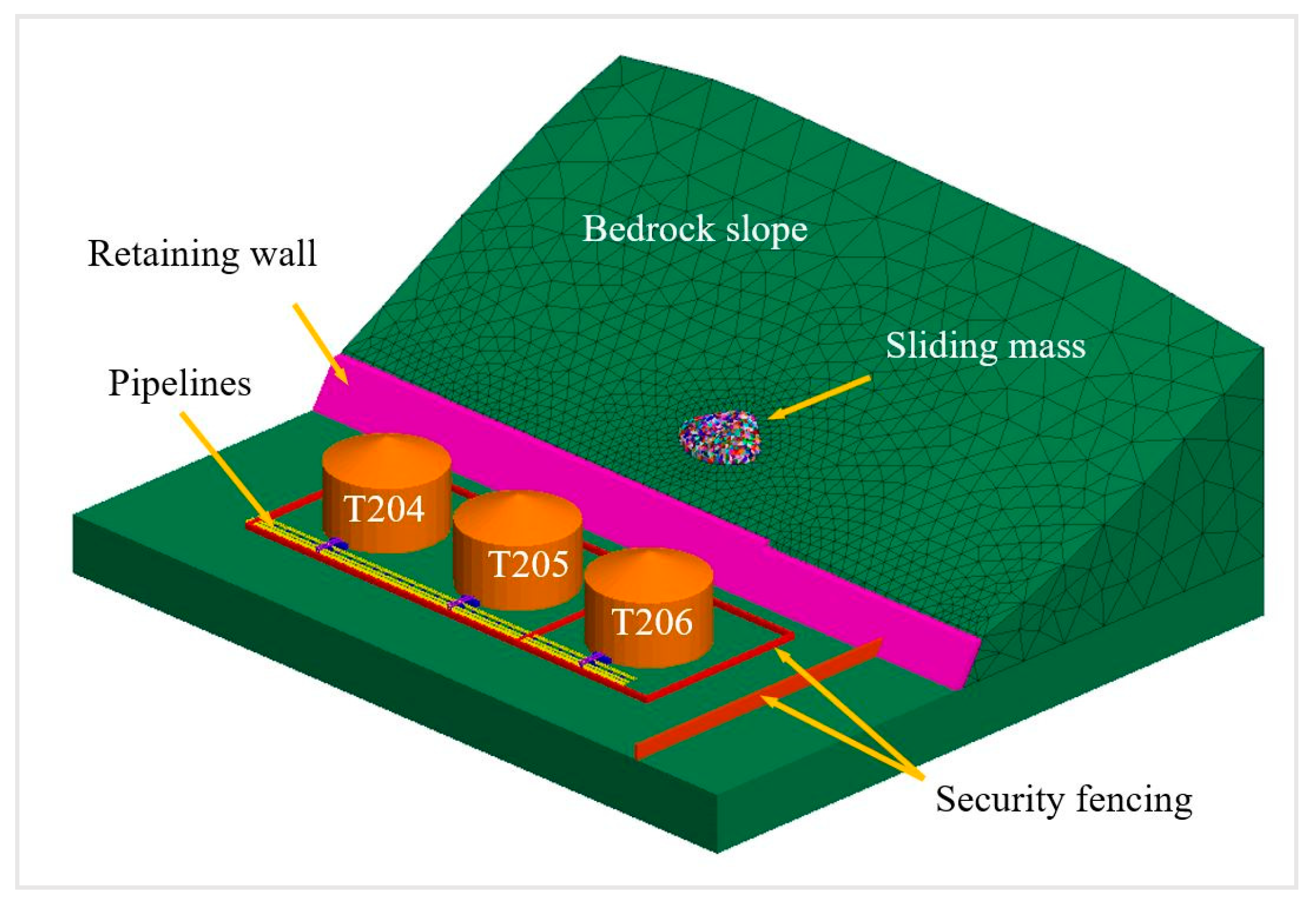
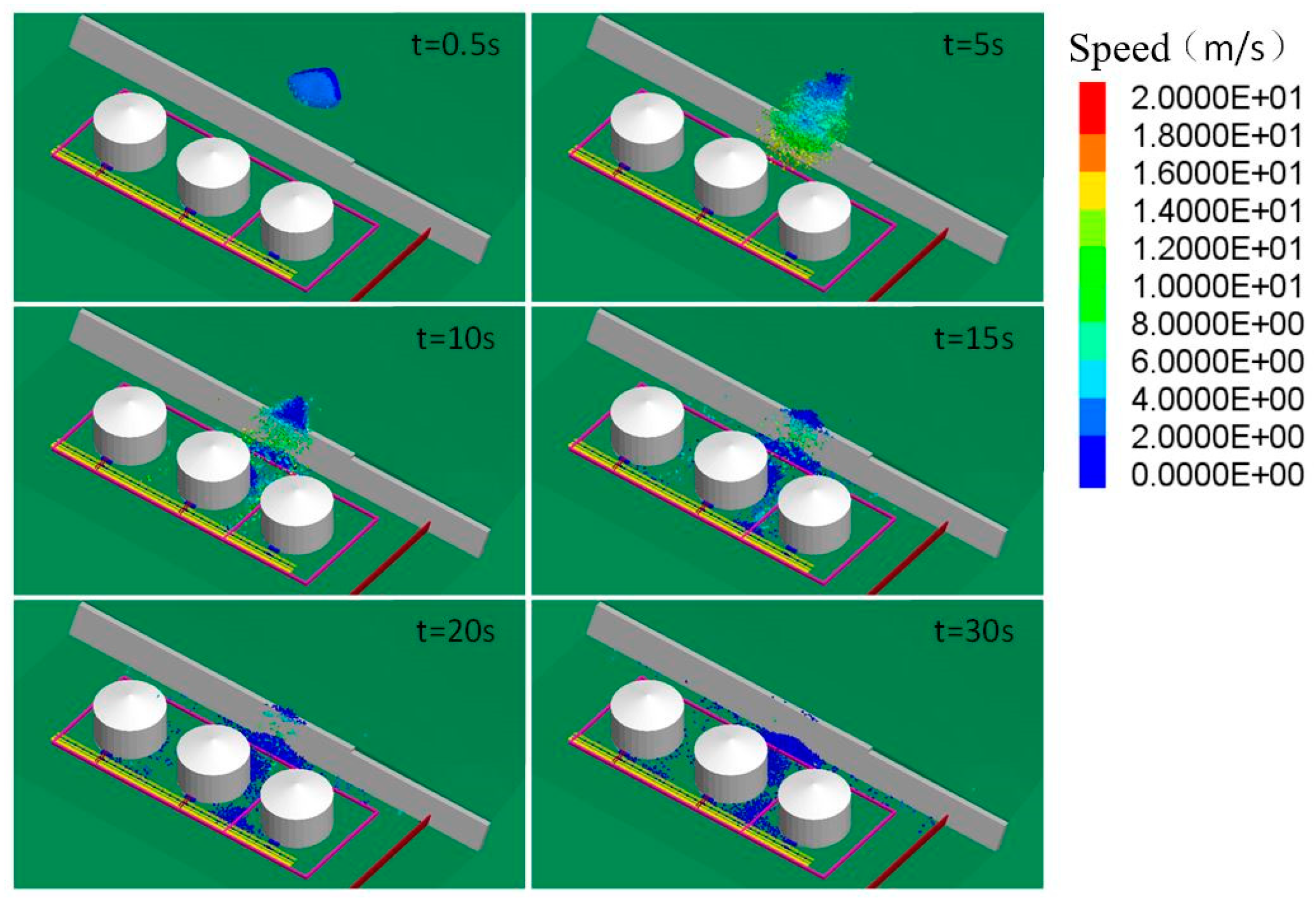
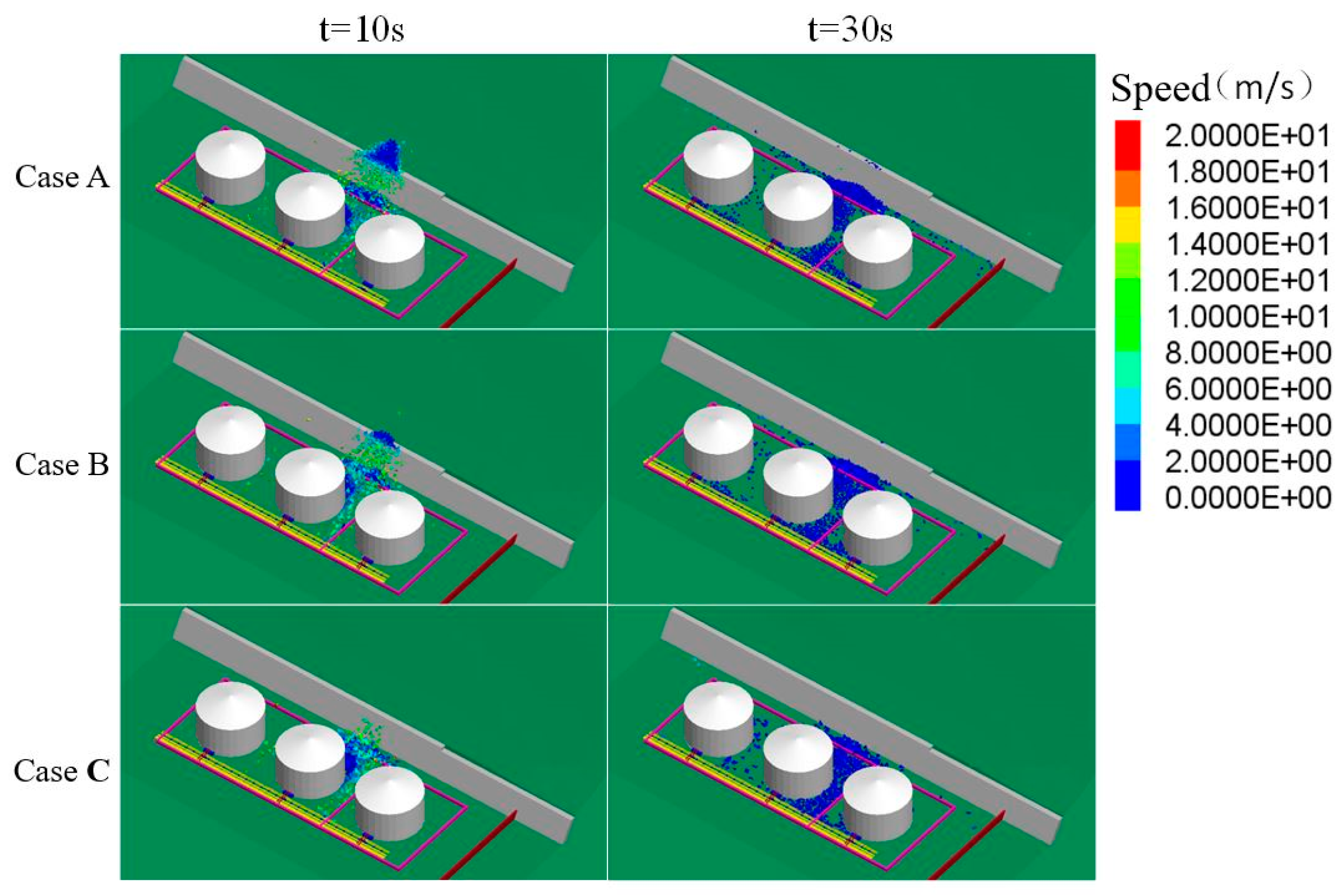
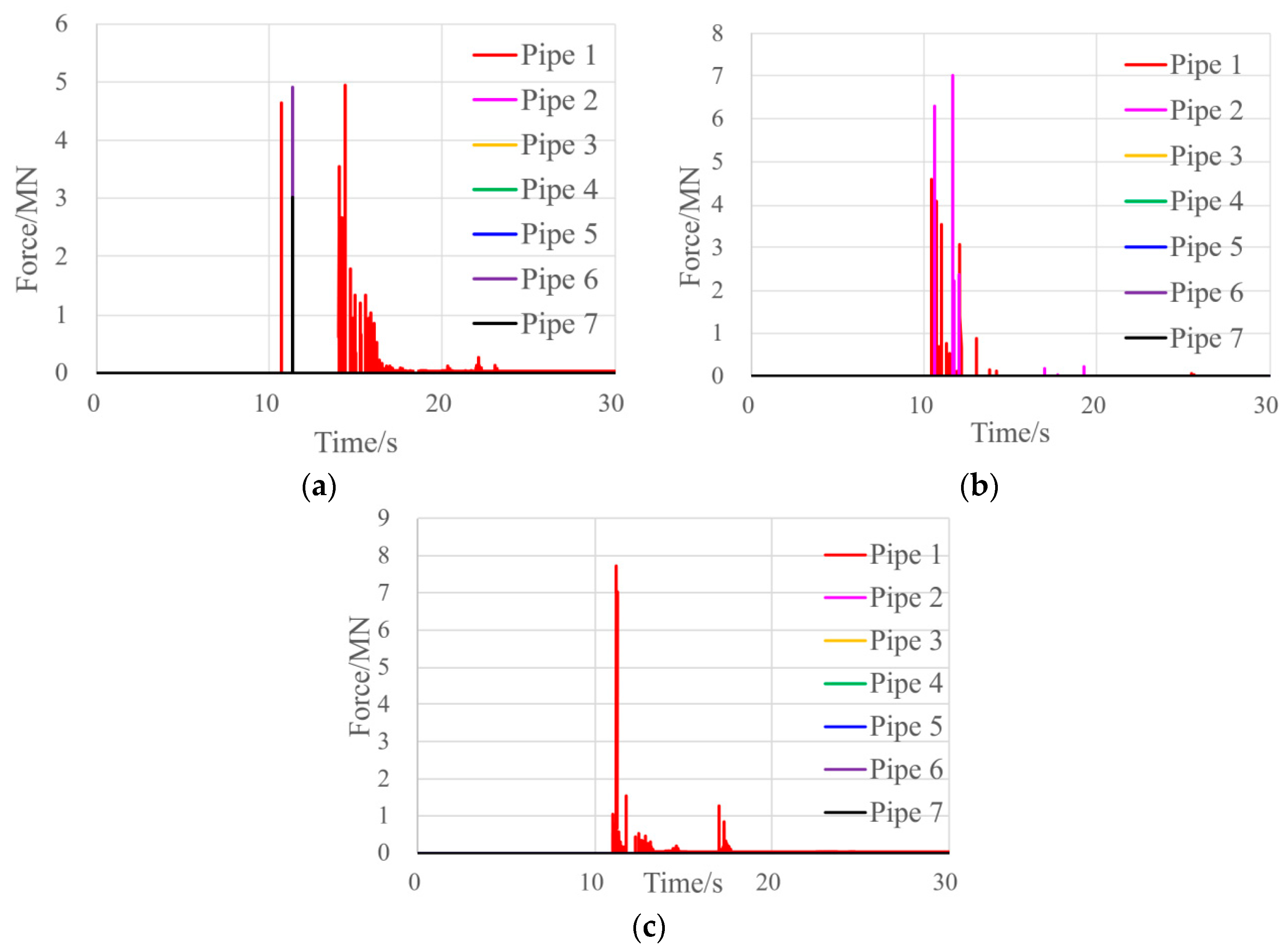
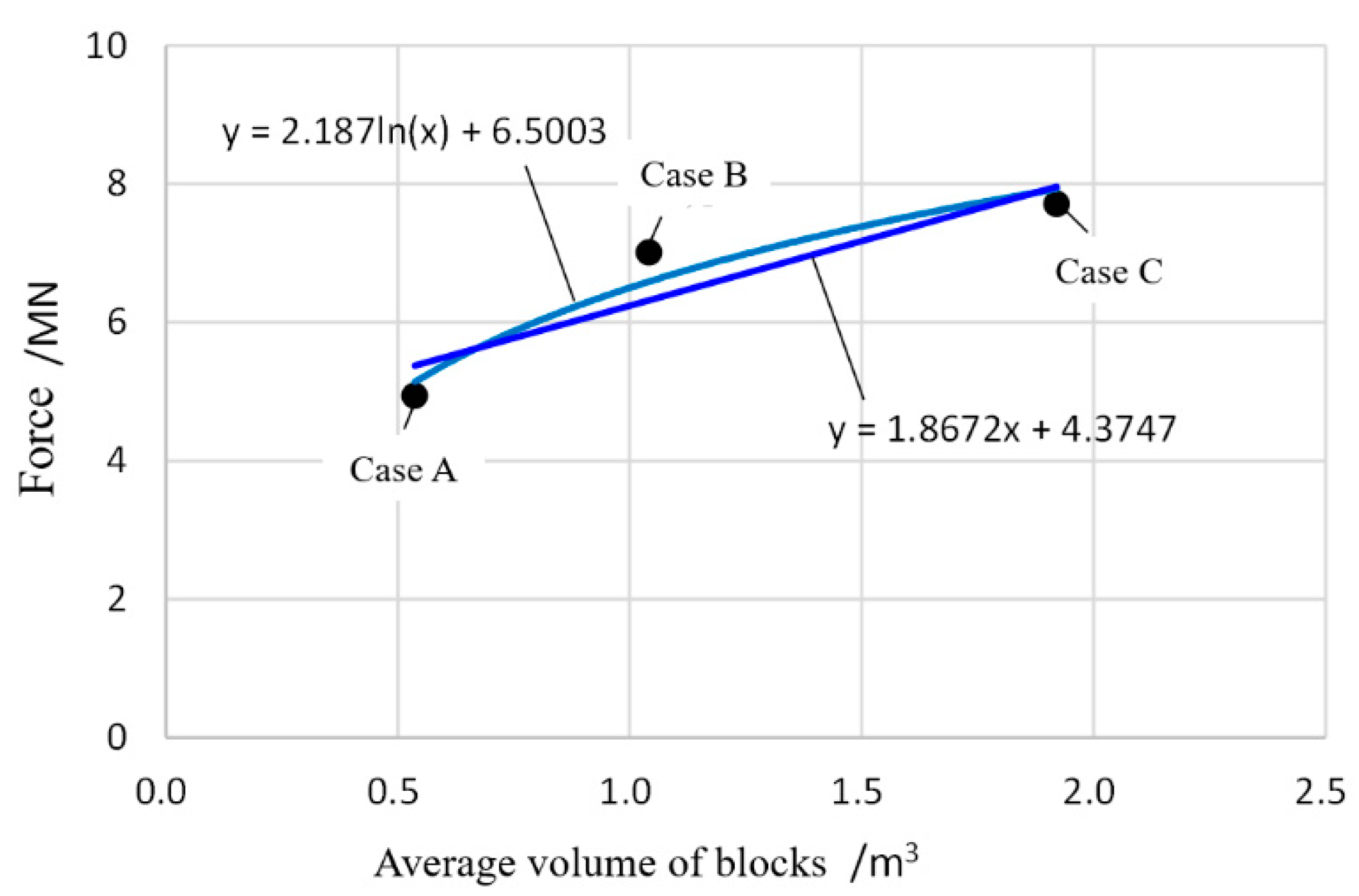

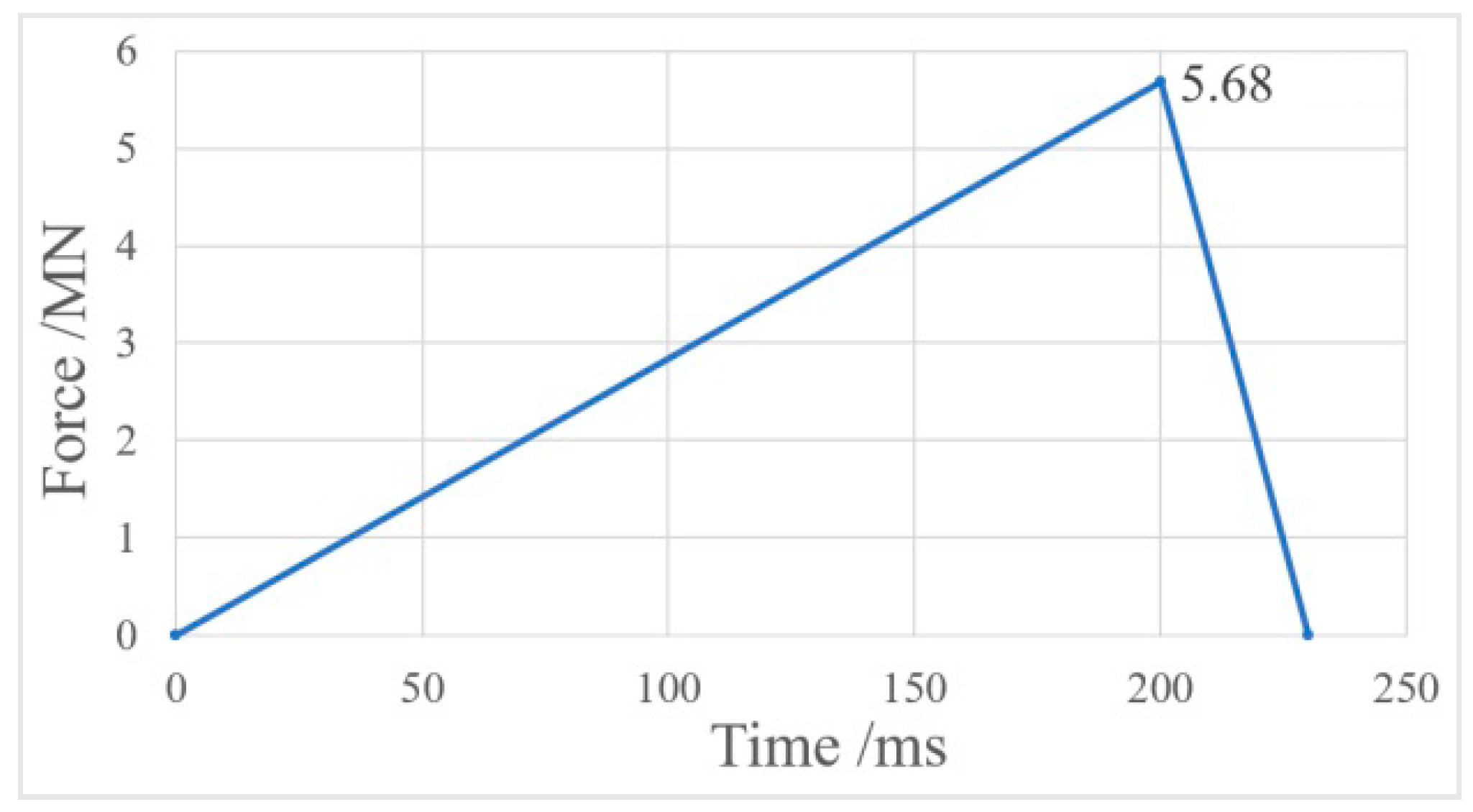
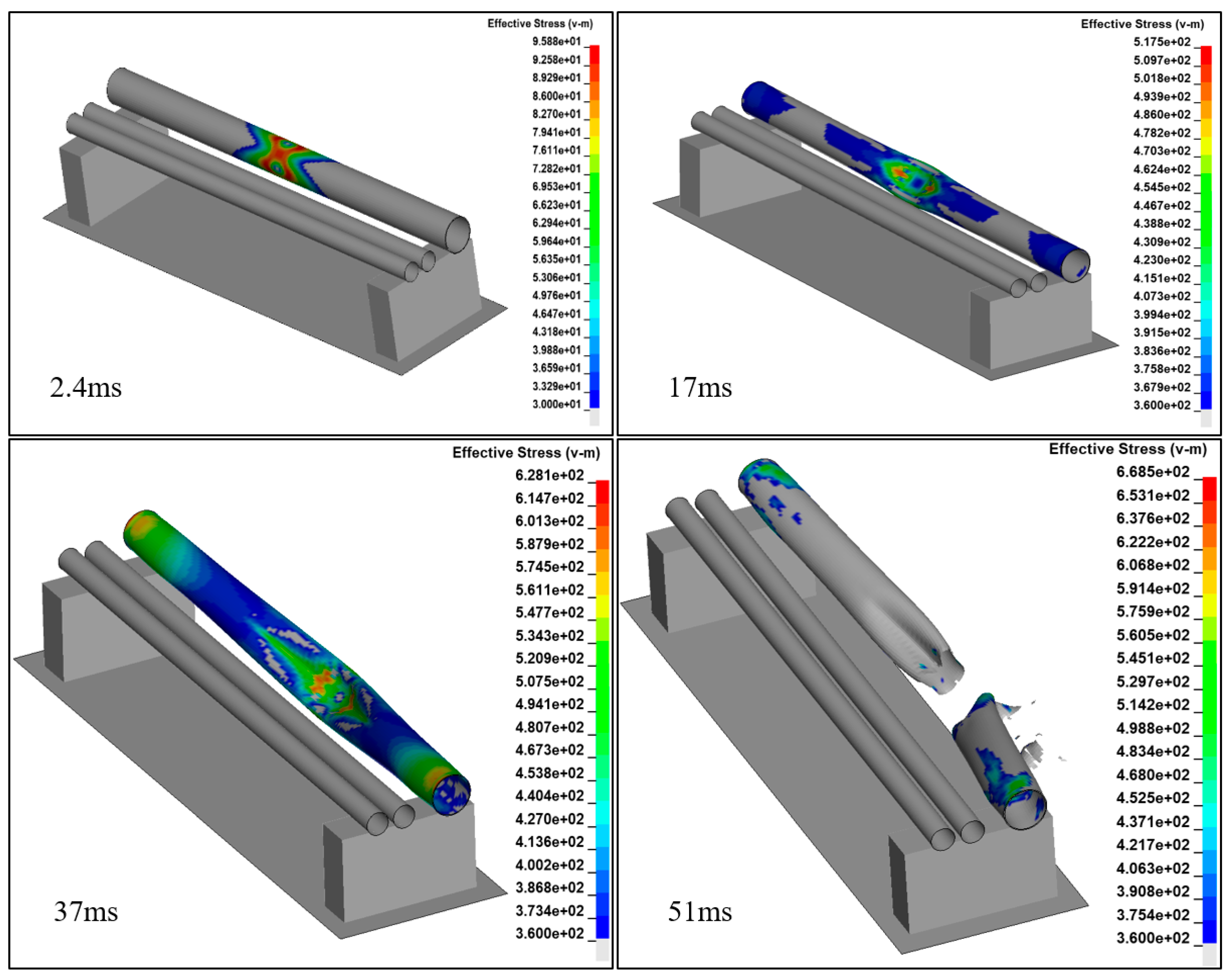
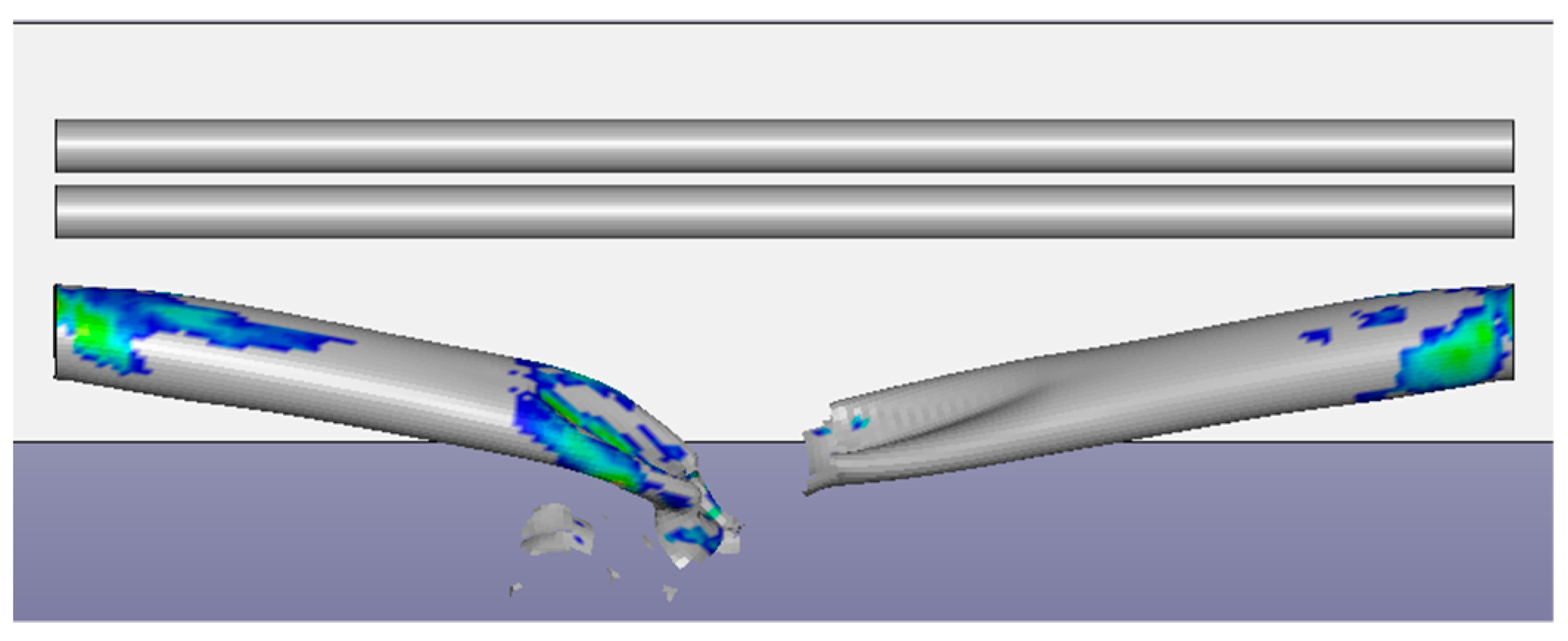
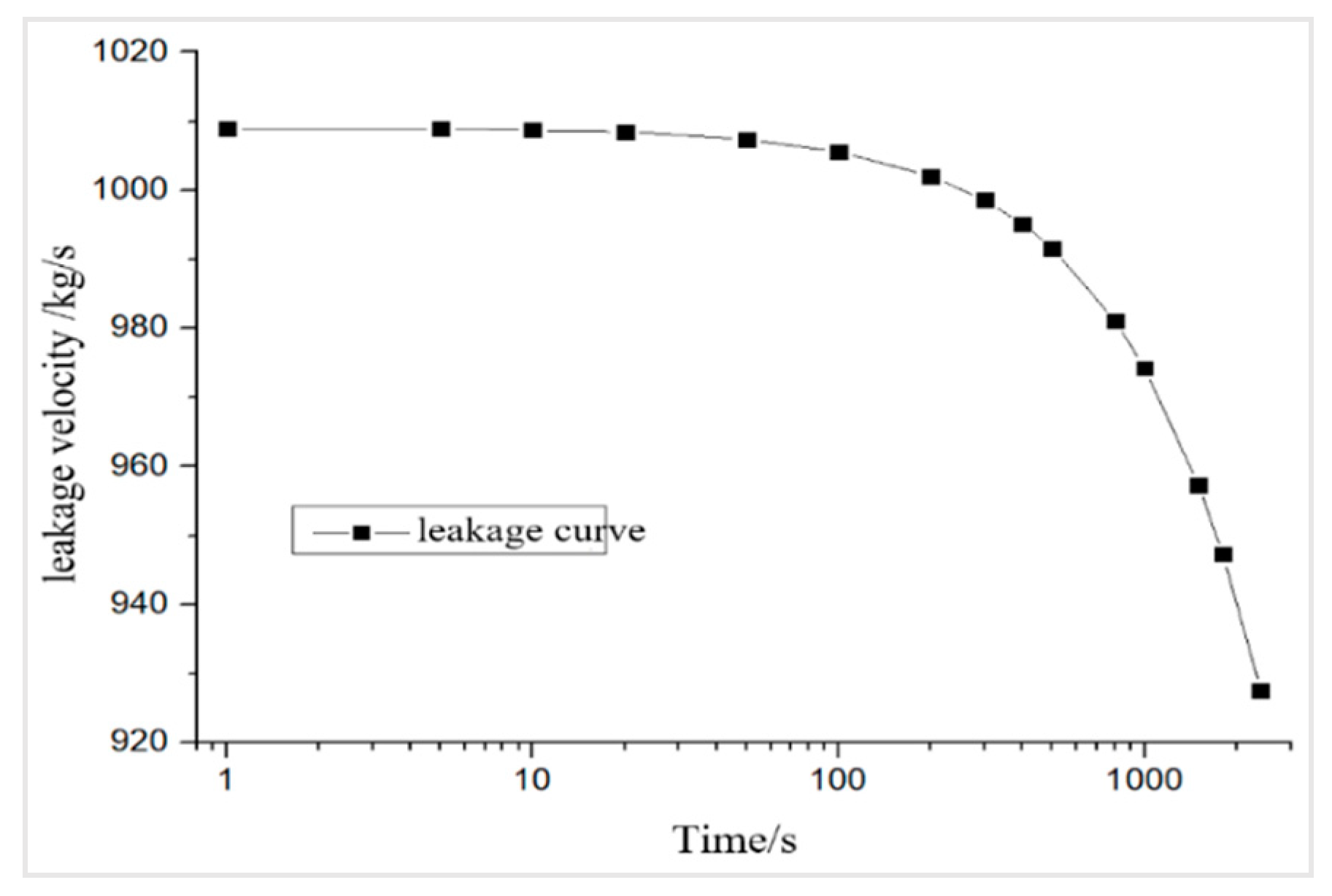
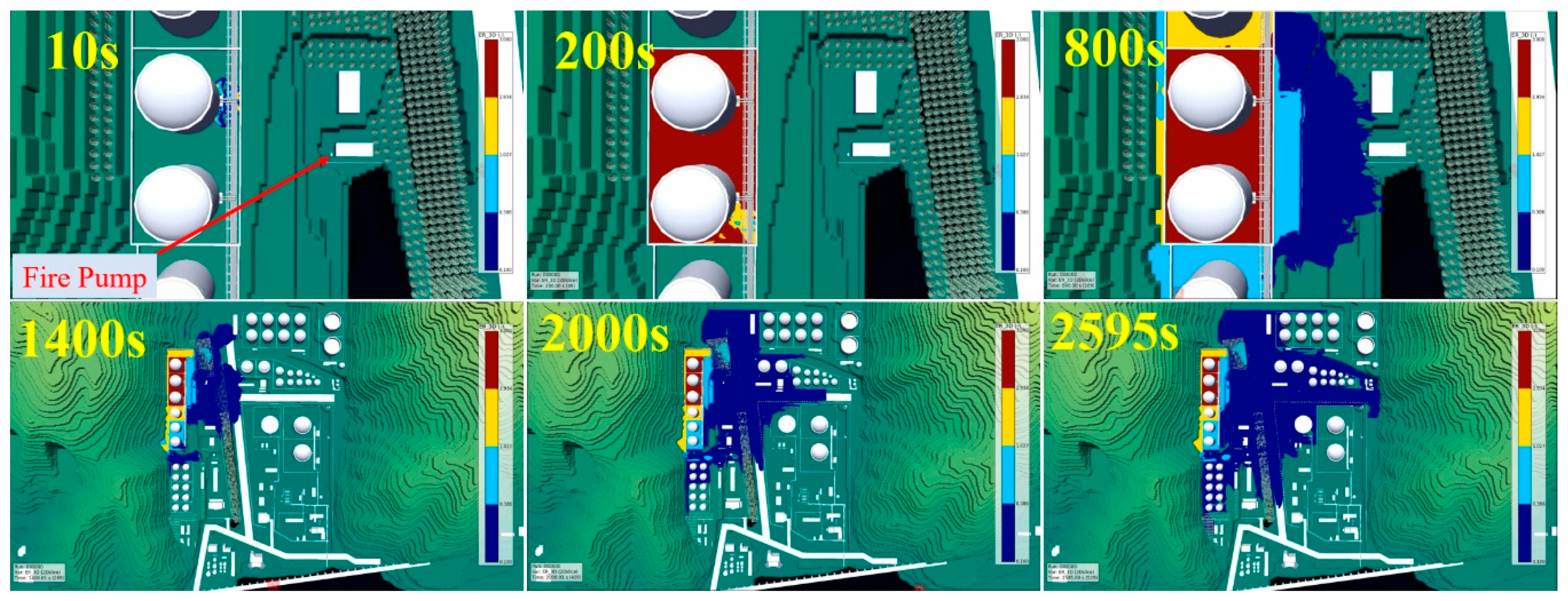
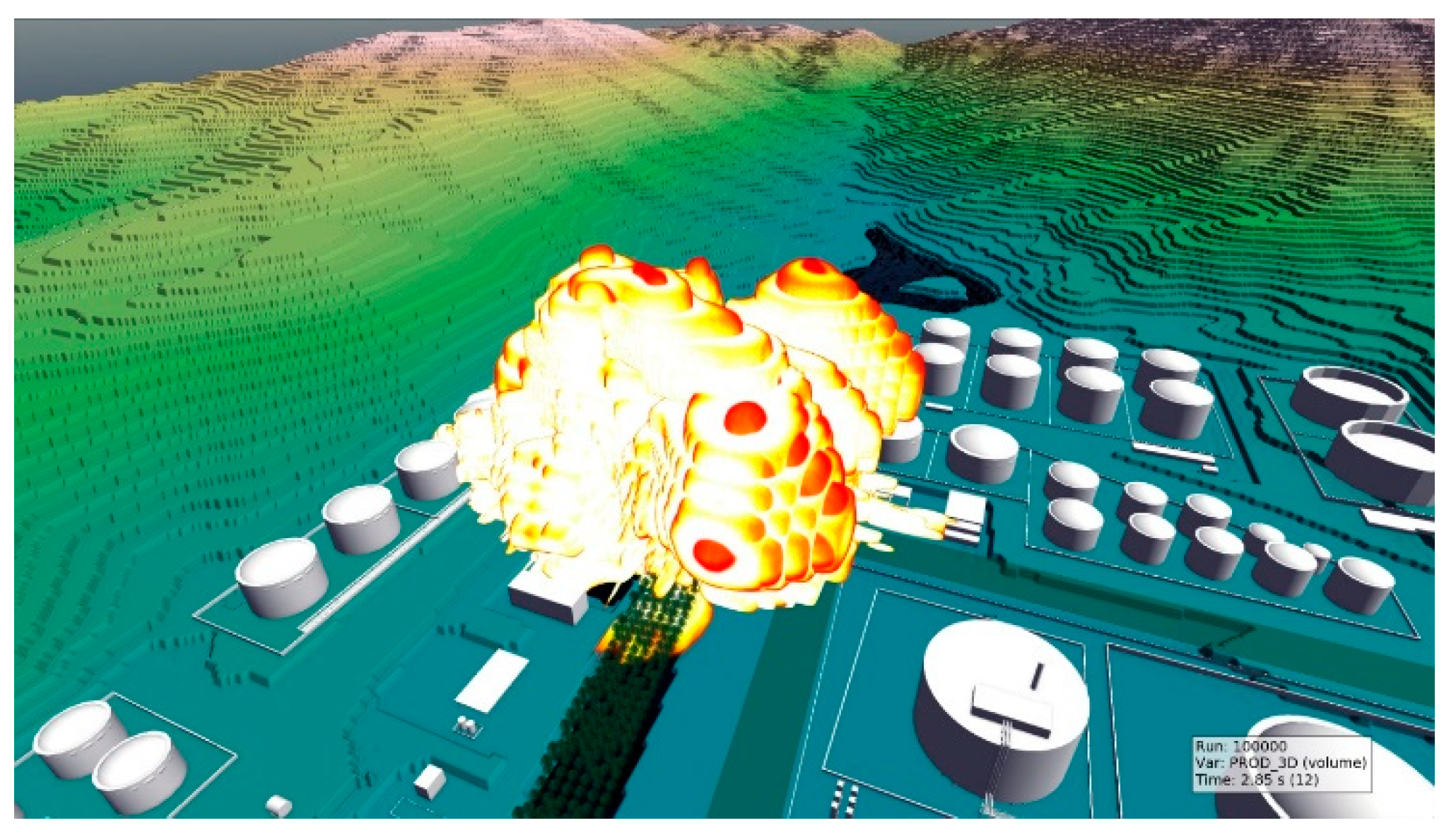
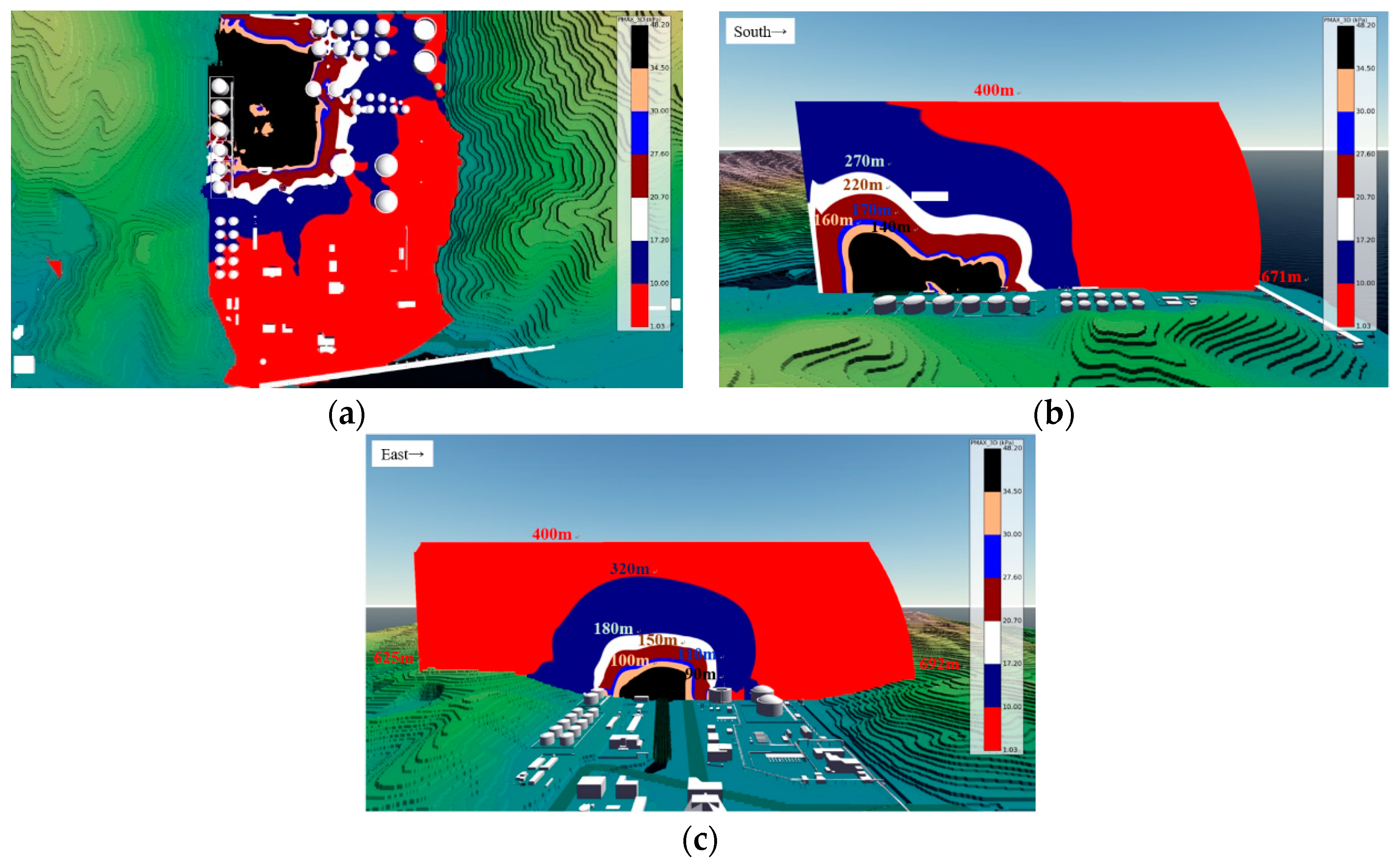

| Block Size Indicator | Case A | Case B | Case C |
|---|---|---|---|
| Maximum size/m3 | 1.42 | 2.40 | 3.70 |
| Minimum size/m3 | 0.18 | 0.38 | 0.37 |
| Mean size/m3 | 0.54 | 1.04 | 1.92 |
| 1. Rigidity Conditions | |||||
|---|---|---|---|---|---|
| Normal Stiffness | Shear Stiffness | ||||
| kn/GPa | ks/GPa | ||||
| 5.0 | 2.5 | ||||
| 2. Strength Conditions | |||||
| Initial Strength | Residual Strength | ||||
| Adhesion C/MPa | Friction angle/o | Tensile strength σt/Mpa | Adhesion C/MPa | Friction angle/o | Tensile strength σt/MPa |
| 0.1 | 30 | 0 | 0 | 15 | 0 |
| Region | Scale of Region | Grid Size/m | ||
|---|---|---|---|---|
| X | Y | Z | ||
| Inner core | XY: within the firewalls where the leaking pipeline was located (108 × 60 m)Z: 25 m above the ground | 0.5 | 0.5 | 0.3 |
| Outer core | XY: within the radius of 150 m Z: 25–70 m | 1 | 1 | 1 |
| Noncore | Other regions | 5 | 5 | 5 |
| Overpressure/kPa | Area |
|---|---|
| 2–10 | Area of minor injury |
| 10–30 | Area of serious injury |
| ≥30 | Area of death |
| Overpressure/kPa | Damage Description |
|---|---|
| 1.03 | Typical pressure for glass breakage |
| 17.2 | 50% destruction of home brickwork |
| 20.7–27.6 | Breakage of oil storage tanks |
| 34.5–48.2 | Nearly complete destruction of houses |
| 30,000 [35] | Breakage of Liquified natural gas (LNG) storage tanks |
Publisher’s Note: MDPI stays neutral with regard to jurisdictional claims in published maps and institutional affiliations. |
© 2020 by the authors. Licensee MDPI, Basel, Switzerland. This article is an open access article distributed under the terms and conditions of the Creative Commons Attribution (CC BY) license (http://creativecommons.org/licenses/by/4.0/).
Share and Cite
Zhang, S.; Xu, D.; Shen, G.; Liu, J.; Yang, L. Numerical Simulation of Na-Tech Cascading Disasters in a Large Oil Depot. Int. J. Environ. Res. Public Health 2020, 17, 8620. https://doi.org/10.3390/ijerph17228620
Zhang S, Xu D, Shen G, Liu J, Yang L. Numerical Simulation of Na-Tech Cascading Disasters in a Large Oil Depot. International Journal of Environmental Research and Public Health. 2020; 17(22):8620. https://doi.org/10.3390/ijerph17228620
Chicago/Turabian StyleZhang, Shaobiao, Dayong Xu, Gansu Shen, Junguo Liu, and Lili Yang. 2020. "Numerical Simulation of Na-Tech Cascading Disasters in a Large Oil Depot" International Journal of Environmental Research and Public Health 17, no. 22: 8620. https://doi.org/10.3390/ijerph17228620





